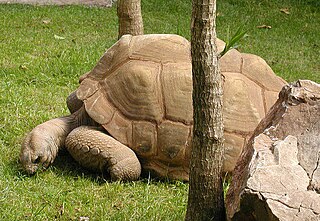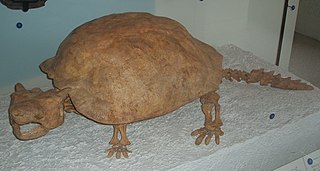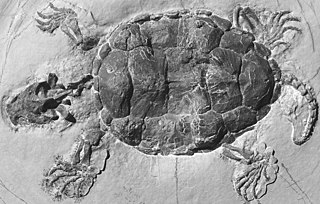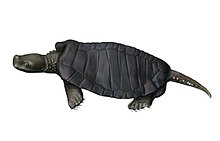
The Trachypachidae are a family of beetles that generally resemble small ground beetles, but that are distinguished by the large coxae of their rearmost legs. There are only six known extant species in the family, with four species of Trachypachus found in northern Eurasia and northern North America, and two species of Systolosoma in Chile and Argentina. They were much more diverse in the past, with dozens of described species from the Mesozoic.

The Cryptodira are a suborder of Testudines that includes most living tortoises and turtles. Cryptodira differ from Pleurodira in that they lower their necks and pull the heads straight back into the shells, instead of folding their necks sideways along the body under the shells' marginals. They include among their species freshwater turtles, snapping turtles, tortoises, softshell turtles, and sea turtles.

Bittacidae is a family of scorpionflies commonly called hangingflies or hanging scorpionflies.

Osmylidae are a small family of winged insects of the net-winged insect order Neuroptera. The osmylids, also called lance lacewings, stream lacewings or giant lacewings, are found all over the world except North and Central America. There are around 225 extant species.

Protostegidae is a family of extinct marine turtles that lived during the Cretaceous period. The family includes some of the largest sea turtles that ever existed. The largest, Archelon, had a head one metre (39 in) long. Like most sea turtles, they had flattened bodies and flippers for front appendages; protostegids had minimal shells like leatherback turtles of modern times.

Paracryptodira is an extinct group of reptiles in the clade Testudinata, known from the Jurassic to Paleogene of North America and Europe. Initially treated as a suborder sister to Cryptodira, they were then thought to be a very primitive lineage inside the Cryptodira according to the most common use of the latter taxon. They are now often regarded as late-diverging stem-turtles, lying outside the clade formed by Cryptodira and Pleurodira. The paracryptodires are said to have phylogenic relationships, noted as primary subclades, within the Baenidae and Pleurosternidae. Within each subclade, lies many biodiverse turtles that are continuously being investigated and added to the fossil record. Paracryptodires are divided into three main groups, Compsemydidae, known from the Late Jurassic to Paleocene of North America and Europe, Pleurosternidae, known from the Late Jurassic to Early Cretaceous of North America and Europe, and Baenidae, known from the Early Cretaceous to Eocene of North America. The latter two groups are more closely related to each other than to Compsemys, forming the clade Baenoidea.

Testudinata is the group of all tetrapods with a true turtle shell. It includes both modern turtles (Testudines) and many of their extinct, shelled relatives (stem-turtles), though excluding Odontochelys and Eorhynchochelys, which are placed in the more inclusive Pantestudines.
Condorchelys was a genus of stem turtle from Early Jurassic Cañadon Asfalto Formation of Argentina. Condorchelys represents the oldest Jurassic-aged Turtle from South America, with only one species described, Condorchelys antiqua.

Coptoclavidae is an extinct family of aquatic beetles in the suborder Adephaga. The Coptoclavidae lived from the Late Triassic to the Early Cretaceous. Coptoclavidae is a member of the adephagan clade Dytiscoidea, which contains other aquatic beetles. Suggested reasons for their extinction to include the rise of teleost fish, or competition with Gyrinidae and Dytiscidae, which possess defensive secretions and sucking channels in the mandibles of larvae, which coptoclavids likely lacked. It has been suggested that the genus Timarchopsis and the subfamily Timarchopsinae are only distantly related to other coptoclavids based on cladistic analysis, with Timarchopsis being more closely related to geadephagans like carabids and trachypachids instead. Another study also suggested similarly for Coptoclavisca and possibly other coptoclaviscines.

Kayentachelys is an extinct genus of turtle known only from the "silty facies" of the Lower Jurassic Kayenta Formation in northeastern Arizona on the lands of the Navajo Nation.
Paleontology or palaeontology is the study of prehistoric life forms on Earth through the examination of plant and animal fossils. This includes the study of body fossils, tracks (ichnites), burrows, cast-off parts, fossilised feces (coprolites), palynomorphs and chemical residues. Because humans have encountered fossils for millennia, paleontology has a long history both before and after becoming formalized as a science. This article records significant discoveries and events related to paleontology that occurred or were published in the year 2011.

Sichuanchelyidae is a family of extinct turtles in the clade Testudinata. It includes all perichelydians that are more closely related to Sichuanchelys than Meiolania, Helochelydra, or any extant turtles.
The Moskvoretskaya Formation is a Middle Jurassic geologic formation in the European part of Russia. It consists of continental claystones, siltstones and sandstones deposited in karstified segments of underlying Middle Carboniferous limestone, that would have formed underground aquifers.

Meiolaniformes is an extinct clade of stem-group turtles, defined as all taxa more closely related to Meiolania than to Cryptodira and Pleurodira. It is known from the Early Cretaceous to the Holocene of Australia, Oceania and South America. Some Eurasian taxa have been suggested to be part of the group, but this is disputed.

Perichelydia is a clade within Pantestudines known from the Middle Jurassic to Holocene. Alongside crown group Testudines, it also contains Helochelydridae, which is known from the Cretaceous of Europe and North America, Sichuanchelyidae from the Middle Jurassic to Paleocene of Asia and Europe, Meiolaniformes, which is known from the Cretaceous to Holocene of South America, Australia and Oceania, and Spoochelys, known from the Mid-Cretaceous Griman Creek Formation of Australia. Kallokibotion from the Late Cretaceous of Europe is also considered part of this group. Several other groups, including the proposed clade Angolachelonia, Paracryptodira, Macrobaenidae, Sinemydidae and Xinjiangchelyidae, which are sometimes considered members of Cryptodira, have also been found outside crown Testudines in several analyses. These groups are usually considered to be closer to the crown group than the other members of Perichelydia.
This list of fossil reptiles described in 2020 is a list of new taxa of fossil reptiles that were described during the year 2020, as well as other significant discoveries and events related to reptile paleontology that occurred in 2020.

Necrotauliidae is an extinct family Mesozoic Amphiesmenoptera. While previously considered a paraphyletic grouping of "basal Trichoptera, basal Lepidoptera, and advanced stem-Amphiesmenoptera", they have recently been considered early diverging caddisflies. Other authors have considered them to be basal amphiesiopterans.

Platychelyidae is an extinct family of pan-pleurodiran turtles, known from the Late Jurassic and Early Cretaceous of Europe, South America, North America, and the Caribbean. It represents the oldest known clade of stem-pleurodires. All known members have been found in marine or coastal deposits. Despite this, their limb morphology suggests that they were not adapted for open marine conditions, but were likely inhabitants of shallow water environments, including brackish and saline waters, and they likely never inhabited environments more marine than lagoons. Their tolerance for saline environments likely aided their dispersal during the breakup of Pangea. Unlike modern pleurodires, which retract their necks to the sides, Platychelys retracted its neck inwards, similar to modern cryptodire turtles. Platychelys is strongly morphologically similar to mata mata and snapping turtles, suggesting that it had a similar ecology as a ram or suction feeder.
Lophioneurida is an extinct order of Thysanoptera, dating from the Carboniferous to the Cretaceous. It is likely paraphyletic, with modern thrips having evolved from members of the group.
This list of fossil reptiles described in 2023 is a list of new taxa of fossil reptiles that were described during the year 2023, as well as other significant discoveries and events related to reptile paleontology that occurred in 2023.
















